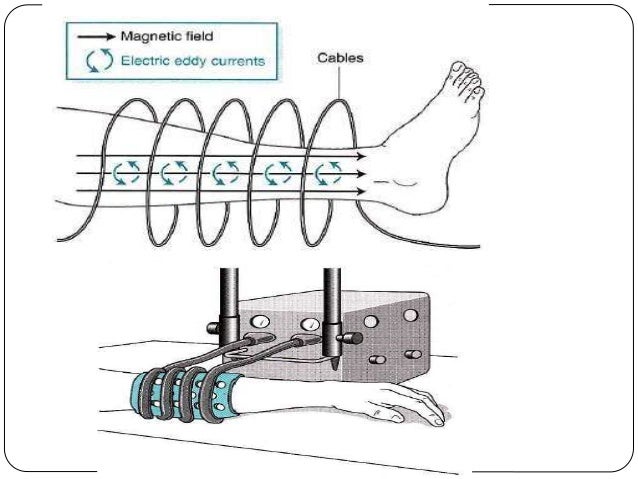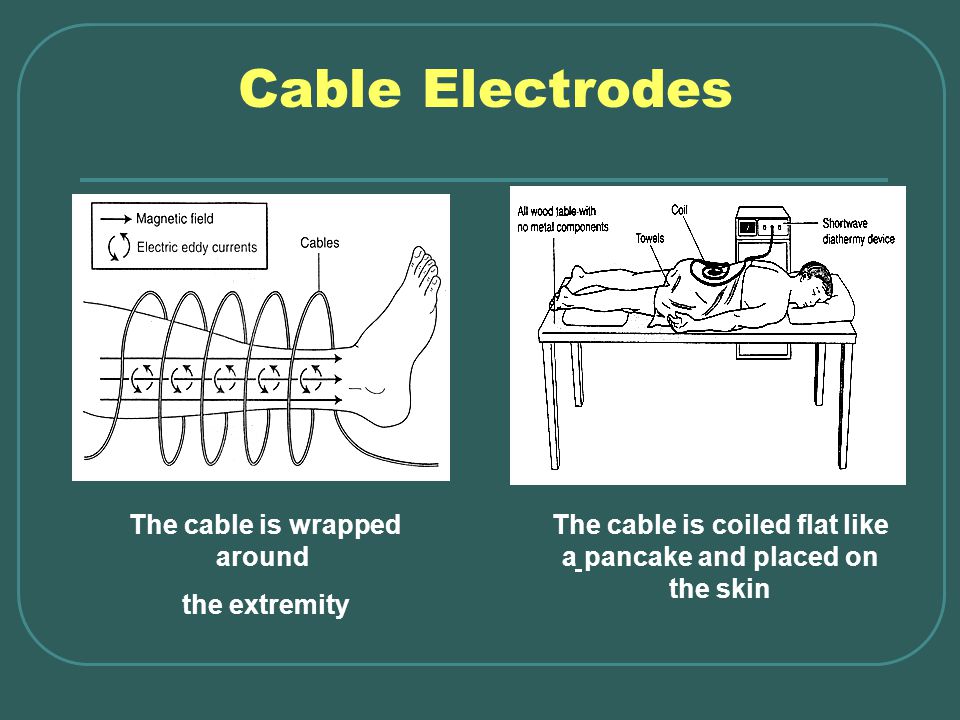SHORT WAVE DIATHERMY
Def.: SWD is a modality that produces deep heating via conversion of electromagnetic energy to thermal energy.
• The pattern of heat produced depend on:
• freq. used.
• type of SWD unit.
• water content of the tissues.
Shortwave diathermy current freq. 10 – 100 MHz
• (The shortest radiofrequency wave is used in therapeutic diathermy.)
• the commonly used in medical work having freq. of 27.12 MHz with wavelength of 11 meters.
Modalities:
• ether continuous or pulsed (PSWD).
* PSWD: application of series of short pulses of SWD so that short periods of SWD interrupted by gaps where there is no SWD.
*The pt. receives lower dose of SWD energy if compared with continuous SWD applied of the same time.
*The tissues will receive lower thermal load.
• SWD: produce both deep and sup. Tissue heating, under certain controlled conditions • it’s applied for 20 min at the max tolerable dose.
Types of Shortwave Diathermy
• Induction Field,
• Capacitive Field.
Induction Field Diathermy:-
• Places the patient in the electromagnetic field
• Current flowing within the coil produces a rotating magnetic field
• Magnetic field produces eddy currents in the tissues
• Eddy currents cause friction that produce heat
• Selectively heats muscle
• Also referred to as:– Magnetic field diathermy


Capacitive Field Diathermy
• Uses the patient’s tissues as a part of the circuit .
• The tissues’ electrical resistance produces heat .
• Selectively heats skin – Muscle is heated via conduction from the adipose.
• Also referred to as “Condenser field diathermy”
TYPES OF ELECTRODES
• Flexible pads: consist of metal electrode encased in rubber and produce an electrostatic field.

• Space plates: consist of a rigid metal electrode encased in a Perspex cover electrostatic field.

• Coil or cable electrode: consists of a wire with plugs at either end creates electromagnetic field.

• The monode: flat, rigid coil encased in plastic cover
electromagnetic field.

• The diplode: or drum electrode, consists of a flat coil electrode encased in a Perspex cover with two wings
electromagnetic field.

FACTORS INFLUENCE FIELD DISTRIBUTION IN S.W.D
◉ Spacing :
•allows the lines of force in the electrostatic field to diverge before entering the tissues. This prevents concentration of heat in the superficial tissues and ensures more heating through the part.
• Spacing provided by:
1. wrapping flexible pads in towel.
2. flat felt spacing pads between pad electrode and skin
3. air when using space plates.
• Normal spacing even field distribution.
• Increased spacing deep field concentration.
• Decreased spacing superficial concentration
◉Electrode size:-
•if the electrodes are too small than the diameter of treated part line of force will be concentrated superficially.
•If the electrodes are markedly larger the line of force will be lost in the air.
•Ideally , the electrodes should be slightly larger than the area treated.
•To concentrate heat on one aspect of the part the electrode should be unequal in size (smaller one placed over the area where concentration of heat is required).
•You can produce concentration of heat by using equal size electrodes but with unequal spacing (25 mm over concentrated area and more than 30 mm on other electrode).
THERAPEUTIC VARIATION IN THE FIELD DISTRIBUTION
Coplanar application to structures on one aspect of the body . If the spacing is less than 25 mm more concentration in the treat superficial tissue.
If spacing Increases more depth achieved.
The distance between adjacent ends must be greater than the sum of skin electrode distance (A+B) otherwise the line of force will pass directly between Electrodes rather than tissues.

•• Contra planar applications :-
• Two flexible pads, two space plates or flexible pad with a space plate are used.
• It is essential to put a cotton towel between the two limbs to any absorb perspiration.

••Cross-fire application:-
For the treatment of sinuses,space plates positioned after half diagonally ,of treatment time the positions are alternate.
this ensures that the all the sinuses membranes are heated.
Care must be taken to avoid direct placement over the eye ,uterine disorders such as dysmenrrohea.
• Application using a coil electrode:-
• 1.The coil wound evenly firmly
• 2 Pancake application

• Application using diplode:-
• 1. Adjust wings of diplode parallel to the skin of the treated area, electromagnetic field will produce.
PHYSIOLOGICAL EFFECTS
The principal effect of SWD on the body is the production of heat in the tissues due to the rise of temperature.
1. Increased metabolism
• Heating tissues accelerates chemical changes such as metabolism, so oxygen and food stuffs are used up.
• With increased metabolism, there will be increased output of waste products.
2. Increased blood supply
• As a result of increased output of waste products such as metabolites, which act on the walls of the capillaries and arterioles, these tissues dilate.
• In addition, heat has direct effect on blood vessels, causing vasodilatation.
• Heat also produces stimulation of superficial nerve endings, causing reflex dilatation of the arterioles.
3. General rise of temperature
• As blood passes through the heated tissues, it also becomes heated and carries the heat to other body parts.
• Rise of temperature induces muscle relaxation and increases the efficiency of muscle action.
4. Fall in blood pressure
• The generalized vasodilatation reduces the peripheral resistance to blood flow.
• Heat also reduces blood viscosity, which helps in the reduction of blood pressure.
5. Increased activity of sweat glands:
• If a general rise of temperature occurs, there will be increased activation of the sweat glands.
Therapeutic Uses
• Musculoskeletal Disorders
Degenerative Joint Disorders Ex. OA and RA
Sprain
Strain
Hematoma
Muscle & tendon Tears
Capsule Lesions
• Inflammatory Conditions
Boils
Carbuncles
Sinusitis
Pelvic Conditions
Infected Surgical Incisions
DANGERS
1. Burns
• Concentration of electric field
• Excess current
• Impaired blood flow
• Hypersensitive skin
• Leads touching skin
1. Scalds
2. Electric shock
3. Overdose
4. Precipitation of gangrene
5. Faintness
6. Giddiness
Contraindications
• Metal implants or metal jewelry (be aware of body piercings)
• Cardiac pacemakers
• Ischemic areas
• Peripheral vascular disease
• Perspiration and moist dressings: The water collects and concentrates the heat.
• Tendency to hemorrhage, including menstruation
• Pregnancy
• Fever
• Sensory loss
• Cancer
• Deep X ray
• Tumours
• Unreliable patients
• Areas of particular sensitivity: – Epiphyseal plates in children
– The genitals
– Sites of infection
– The abdomen with an implanted intrauterine device (IUD)
– The eyes and face
– Application through the skull


No comments:
Post a Comment